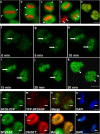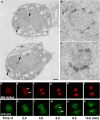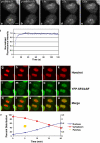Hypophosphorylated SR splicing factors transiently localize around active nucleolar organizing regions in telophase daughter nuclei
- PMID: 15479736
- PMCID: PMC2172523
- DOI: 10.1083/jcb.200404120
Hypophosphorylated SR splicing factors transiently localize around active nucleolar organizing regions in telophase daughter nuclei
Abstract
Upon completion of mitosis, daughter nuclei assemble all of the organelles necessary for the implementation of nuclear functions. We found that upon entry into daughter nuclei, snRNPs and SR proteins do not immediately colocalize in nuclear speckles. SR proteins accumulated in patches around active nucleolar organizing regions (NORs) that we refer to as NOR-associated patches (NAPs), whereas snRNPs were enriched at other nuclear regions. NAPs formed transiently, persisting for 15-20 min before dissipating as nuclear speckles began to form in G1. In the absence of RNA polymerase II transcription, NAPs increased in size and persisted for at least 2 h, with delayed localization of SR proteins to nuclear speckles. In addition, SR proteins in NAPs are hypophosphorylated, and the SR protein kinase Clk/STY colocalizes with SR proteins in NAPs, suggesting that phosphorylation releases SR proteins from NAPs and their initial target is transcription sites. This work demonstrates a previously unrecognized role of NAPs in splicing factor trafficking and nuclear speckle biogenesis.
Figures








References
-
- Andersen, F.F., T.O. Tange, T. Sinnathamby, J.R. Olesen, K.E. Andersen, O. Westergaard, J. Kjems, and B.R. Knudsen. 2002. The RNA splicing factor ASF/SF2 inhibits human topoisomerase I mediated DNA relaxation. J. Mol. Biol. 322:677–686. - PubMed
-
- Christensen, M.O., H.U. Barthelmes, F. Boege, and C. Mielke. 2002. The N-terminal domain anchors human topoisomerase I at fibrillar centers of nucleoli and nucleolar organizer regions of mitotic chromosomes. J. Biol. Chem. 277:35932–35938. - PubMed
-
- Colwill, K., L.L. Feng, J.M. Yeakley, G.D. Gish, J.F. Caceres, T. Pawson, and X.D. Fu. 1996. a. SRPK1 and Clk/Sty protein kinases show distinct substrate specificities for serine/arginine-rich splicing factors. J. Biol. Chem. 271:24569–24575. - PubMed
Publication types
MeSH terms
Substances
Grants and funding
LinkOut - more resources
Full Text Sources
Research Materials

